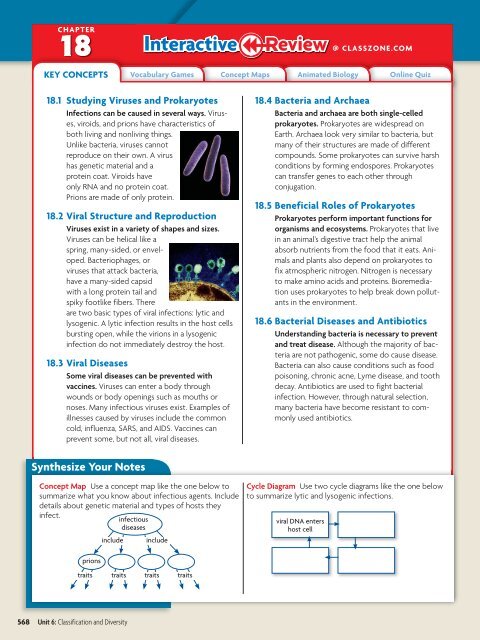18.1 Studying Viruses and Prokaryotes
18.1 Studying Viruses and Prokaryotes
18.1 Studying Viruses and Prokaryotes
Create successful ePaper yourself
Turn your PDF publications into a flip-book with our unique Google optimized e-Paper software.
CHAPTER18@ CLASSZONE.COMKEY CONCEPTS Vocabulary Games Concept Maps Animated Biology Online Quiz<strong>18.1</strong> <strong>Studying</strong> <strong>Viruses</strong> <strong>and</strong> <strong>Prokaryotes</strong>Infections can be caused in several ways. <strong>Viruses</strong>,viroids, <strong>and</strong> prions have characteristics ofboth living <strong>and</strong> nonliving things.Unlike bacteria, viruses cannotreproduce on their own. A virushas genetic material <strong>and</strong> aprotein coat. Viroids haveonly RNA <strong>and</strong> no protein coat.Prions are made of only protein.18.2 Viral Structure <strong>and</strong> Reproduction<strong>Viruses</strong> exist in a variety of shapes <strong>and</strong> sizes.<strong>Viruses</strong> can be helical like aspring, many-sided, or enveloped.Bacteriophages, orviruses that attack bacteria,have a many-sided capsidwith a long protein tail <strong>and</strong>spiky footlike fibers. Thereare two basic types of viral infections: lytic <strong>and</strong>lysogenic. A lytic infection results in the host cellsbursting open, while the virions in a lysogenicinfection do not immediately destroy the host.18.3 Viral DiseasesSome viral diseases can be prevented withvaccines. <strong>Viruses</strong> can enter a body throughwounds or body openings such as mouths ornoses. Many infectious viruses exist. Examples ofillnesses caused by viruses include the commoncold, influenza, SARS, <strong>and</strong> AIDS. Vaccines canprevent some, but not all, viral diseases.18.4 Bacteria <strong>and</strong> ArchaeaBacteria <strong>and</strong> archaea are both single-celledprokaryotes. <strong>Prokaryotes</strong> are widespread onEarth. Archaea look very similar to bacteria, butmany of their structures are made of differentcompounds. Some prokaryotes can survive harshconditions by forming endospores. <strong>Prokaryotes</strong>can transfer genes to each other throughconjugation.18.5 Beneficial Roles of <strong>Prokaryotes</strong><strong>Prokaryotes</strong> perform important functions fororganisms <strong>and</strong> ecosystems. <strong>Prokaryotes</strong> that livein an animal’s digestive tract help the animalabsorb nutrients from the food that it eats. Animals<strong>and</strong> plants also depend on prokaryotes tofix atmospheric nitrogen. Nitrogen is necessaryto make amino acids <strong>and</strong> proteins. Bioremediationuses prokaryotes to help break down pollutantsin the environment.18.6 Bacterial Diseases <strong>and</strong> AntibioticsUnderst<strong>and</strong>ing bacteria is necessary to prevent<strong>and</strong> treat disease. Although the majority of bacteriaare not pathogenic, some do cause disease.Bacteria can also cause conditions such as foodpoisoning, chronic acne, Lyme disease, <strong>and</strong> toothdecay. Antibiotics are used to fight bacterialinfection. However, through natural selection,many bacteria have become resistant to commonlyused antibiotics.Synthesize Your NotesConcept Map Use a concept map like the one below tosummarize what you know about infectious agents. Includedetails about genetic material <strong>and</strong> types of hosts theyinfect.infectiousdiseasesincludeincludeCycle Diagram Use two cycle diagrams like the one belowto summarize lytic <strong>and</strong> lysogenic infections.viral DNA entershost cellprionstraits traits traits traits568 Unit 6: Classification <strong>and</strong> Diversity
















